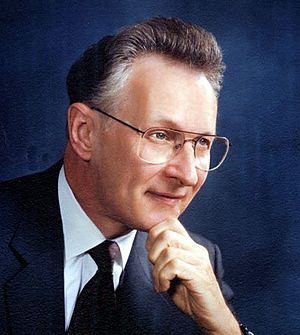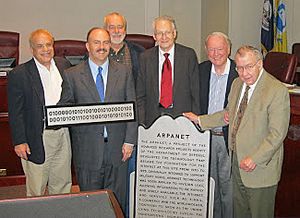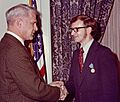Stephen J. Lukasik facts for kids
Quick facts for kids
Steve Lukasik
|
|
|---|---|
 |
|
| Born |
Stephen Joseph Lukasik
March 19, 1931 Staten Island, New York, U.S.
|
| Died | October 3, 2019 (aged 88) Fairfax, Virginia, U.S.
|
| Nationality | American |
| Other names | Steve Lukasik |
| Alma mater | Rensselaer Polytechnic Institute (B.S., Physics, 1951), Massachusetts Institute of Technology (Ph.D., Physics, 1956) |
| Known for | DARPA Director, WMD control techniques |
| Spouse(s) | Virginia Dogan Lukasik |
| Awards |
|
| Scientific career | |
| Fields | National Defense Science R&D, Weapons of Mass Destruction control, Telecommunications |
| Institutions | MIT, BBN, Westinghouse Bettis Atomic Power Laboratory, Stevens Institute of Technology, DARPA, Xerox, RAND, FCC, Northrop, TRW, SAIC |
Stephen Joseph Lukasik (March 19, 1931 – October 3, 2019) was an American physicist. He held many important jobs in science and defense. He helped create new technologies for national defense. He also worked on ways to find and control dangerous weapons, especially nuclear ones.
Lukasik was the second longest-serving Director of DARPA. This agency develops new technologies for the military. During his time, many new inventions came out, including early versions of the internet. He was also the first Chief Scientist for the Federal Communications Commission (FCC). There, he helped bring new technologies like Wi-Fi to people.
Contents
Early Life and Education
Stephen Lukasik was born in Staten Island, New York. His family had roots from many different countries. When he was in high school, he became very interested in physics. After hearing about the atomic bomb used in Hiroshima in 1945, he decided to focus on controlling nuclear weapons for his life's work.
He went to Rensselaer Polytechnic Institute and earned a degree in physics in 1951. Five years later, he got his Ph.D. in physics from the Massachusetts Institute of Technology (MIT). While studying at MIT, he also worked at BBN Technologies. There, he studied how waves behave, which was important for security.
Career in Science and Defense
After finishing his studies, Lukasik worked at Westinghouse Bettis Atomic Laboratory. He helped improve computer codes for nuclear safety. In 1957, he moved to Stevens Institute of Technology. He started a new division there that studied how fluids move. His team developed new ways to create strong magnetic fields and study ocean waves. He also taught physics and ran the computer center at Stevens.
In 1961, he worked as a consultant on a system to detect nuclear tests from balloons. This work led him to join the Department of Defense Advanced Research Projects Agency (DARPA) in 1966.
Leading Nuclear Test Detection
At DARPA, Lukasik became the Director of Nuclear Test Detection. He worked on ways to check if countries were following nuclear test ban agreements. His team developed systems like the Norwegian Large Aperture Seismic Array. This system helped detect underground nuclear explosions. He also studied how countries might try to cheat on these treaties. This research was important for new agreements, like the Threshold Nuclear Test Ban Treaty signed in 1974.
Director of DARPA
Lukasik became the Deputy Director of DARPA in 1967 and then the Director in 1970. He held this important job until 1975. This time was very exciting for new technologies. Many research projects from DARPA were turned into real systems for the military and for everyday people.
Some of the big projects during his time included:
- Expanding the ARPANET, which was an early version of the internet.
- Developing new internet rules (protocols).
- Creating "smart weapons" that could aim themselves.
- Improving ways to find submarines using long underwater microphones.
- Working on artificial intelligence and speech recognition.
- Developing unmanned aerial vehicles (drones).
Lukasik also helped create a long-term research plan for DARPA in 1973. This plan guided research for the next 30 years. It included ideas like network-centric warfare (using networks for military operations), stealth technology (making planes hard to detect), and precision systems. He also helped start a secret journal to share research on tactical warfare.
Work in Technology and Public Policy
After leaving DARPA in 1975, Lukasik joined Xerox Corporation. He helped set up a division to create office products that could connect to networks. These products used new technologies like Ethernet, early personal computers (ALTO), and laser printing.
Three years later, he became a Vice President at the RAND Corporation. He worked on national security programs and was their Chief Scientist. He also taught about technology and public policy.
Chief Scientist at the FCC
In 1979, Lukasik became the first Chief Scientist for the Federal Communications Commission (FCC). He helped organize their technical teams into the Office of Science and Technology.
At the FCC, he made it easier for direct broadcast satellites to be used. He also started the process that led to the rules for unlicensed radio bands in 1985. These rules are the reason we have Wi-Fi, Bluetooth, and many other wireless products today! He also helped the FCC plan for future technologies. His work included looking into how radio waves from communication systems might affect health.
Later Career and Contributions
Lukasik continued to work in important roles. In 1982, he joined Northrop as a Vice President. There, he helped develop new security technologies. These included tiny sensors for smart weapons and stealth technology for the B-2 bomber.
In 1990, he became Vice President of Technology for TRW's Space and Defense Sector. He worked on using defense technologies for civilian purposes after the Cold War ended.
From 1992, he worked with SAIC (Science Applications International Corporation). He helped with projects like smart highway systems and using military simulation technology for entertainment. After the attacks in 2001, he worked on understanding terrorism and planning responses to potential attacks.
In his later years, Lukasik was a research fellow at Georgia Tech. He studied how to protect important computer systems and how countries might use cyber attacks. He always believed in focusing on the biggest challenges facing organizations.
Awards and Honors
Stephen Lukasik received many awards for his important work:
- He was given the Department of Defense Distinguished Civilian Service Award twice. The first time was in 1973, and again in 1974. The second award included an Oak Leaf Cluster, which means it was a second award of the same kind. He received it for his many achievements as DARPA Director.
- In 1974, the country of South Korea gave him the Order of National Security Merit Tong-Il Medal. This was for his help in starting South Korea's Agency for Defense Development.
Images for kids
Patents and Publications
Lukasik was awarded two patents in 2012 and 2013. These inventions were for sensors that could detect chemical warfare and for improving signals using tiny technology called nanotechnology.
He also wrote hundreds of articles, presentations, and papers throughout his long career. Some of his important writings included topics like protecting computer networks, why the ARPANET was built, and how to deal with cyber attacks.




